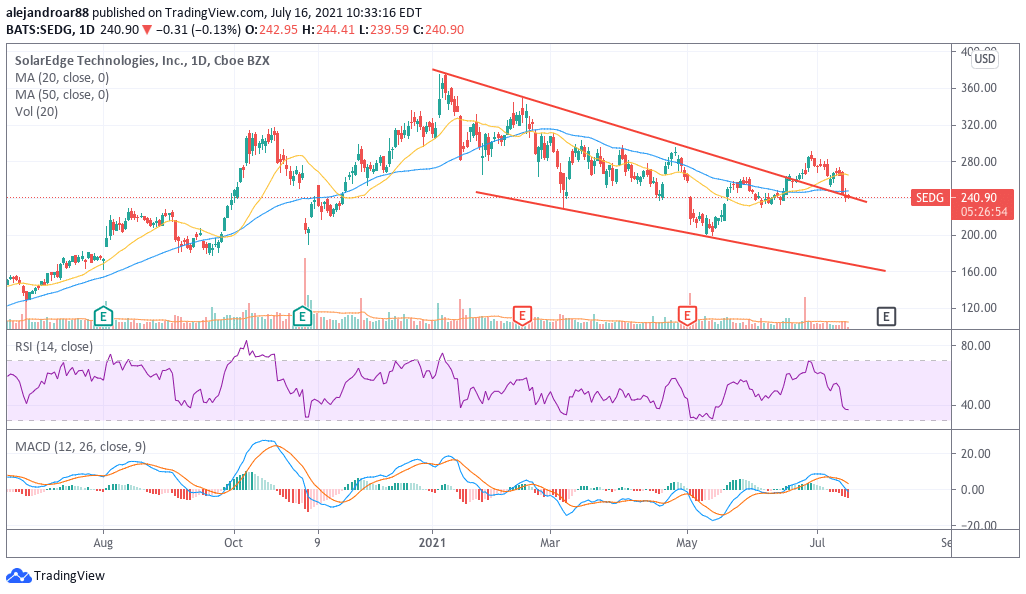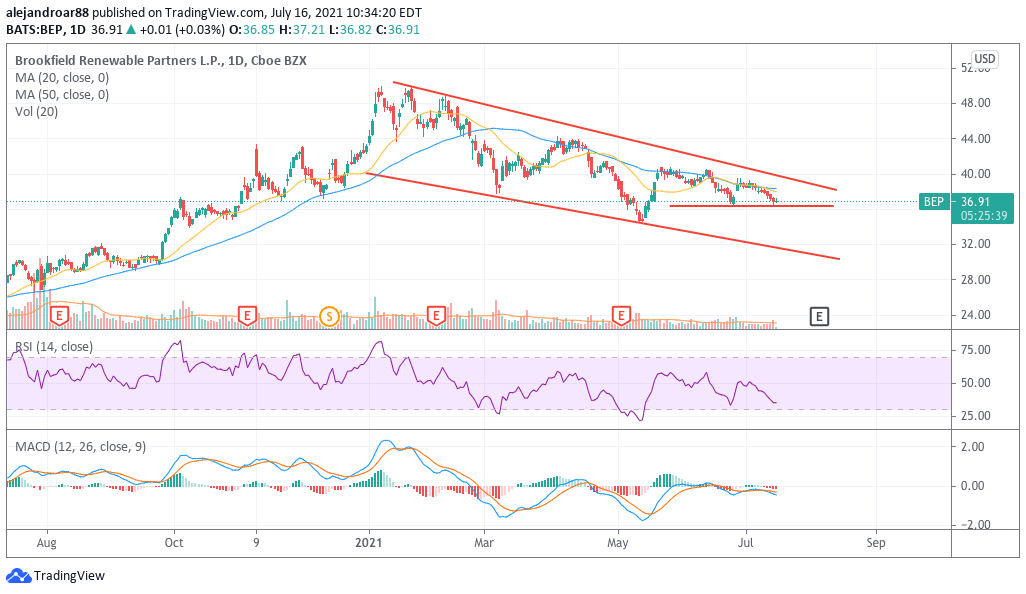5 Best Solar Stocks to Buy in July 2021
Please note that we are not authorised to provide any investment advice. The content on this page is for information purposes only.
This year hasn’t been the most kind for solar stocks, at least until now, as the whole sector has experienced negative performance after delivering eye-popping gains last year.
However, this temporary drop in the valuation of solar companies could provide an opportunity for late buyers to step into this promising and growing segment of the energy sector at more decent multiples.
The following is a list of five names that currently trade at attractive multiples and whose growth prospects could deliver the kind of gains seen in the past once the current downtrend starts to reverse its course.
1. SolarEdge Technologies (SEDG)

SolarEdge is an Israel-based solar company that manufactures and installs solar inverters and other similar solutions to residential and commercial customers primarily in Europe and the United States, currently trading at a market capitalization of $12.5 billion.
In the past three years, the company managed to more than double its top-line results, with revenues moving from $607 million in 2017 to $1.46 billion by the end of last year.
Last year was particularly disappointing as the firm’s revenues stood nearly unchanged as a result of the disruptions the pandemic caused to SolarEdge’s operations but analysts are expecting to see sales growth accelerating again this year, possibly landing at $1.9 billion.
The company’s profit margins have been deteriorating recently, which is a negative factor, but the company’s balance sheet remains conservatively financed as it is displaying a long-term debt of $677 million on assets of $2.5 billion including $868 million in cash.
Currently trading at a forward P/E ratio of 46 and based on analysts forecasted EPS growth of around 40%, SolarEdge appears to be conservatively valued since, at some point in the future, growth rates should accelerate once solar energy solutions start to be widely adopted by companies to achieve their net-zero carbon emissions targets.
67% of all retail investor accounts lose money when trading CFDs with this provider.
2. Generac Holdings (GNRC)
Generac Holdings is a well-known power generation company that operates from Wisconsin and employs over 6,000 people. The company has specialized for years in manufacturing and selling energy storage and other power generation systems for both residential and commercial uses but seems to be increasingly focusing on developing solar technologies as indicated by the firm’s latest acquisitions.
Only a few days ago, Generac announced that it had acquired a microinverter manufacturing business called Chilicon Power while the company has also purchased other similar businesses in the past including Pika Energy and Neurio Technology.
According to its latest annual report, the company plans to introduce a “line of clean energy product marketed under the Generac brand using the names PWRcell™ and PWRview™.
The firm expects that the market for these products will “grow significantly” as the energy landscape keeps favoring renewable power.
Meanwhile, Generac is a highly attractive venture that has been growing its top-line results by the low double-digits in the past few years, while profit margins have been improving in the past three years as well.
By the end of the first quarter of 2021, the firm had $930 million in debt on total assets of $3.4 billion including $745 million in cash and equivalents while its free cash flows have more than doubled recently, moving from $200 million in 2018 to $420 million by the end of 2020.
Currently being valued at 42 times its forecasted earnings per share for the next twelve months, Generac is a fairly valued growth company that could be successfully positioning itself as a leading provider of solar energy products at a point when the market is rapidly shifting toward renewable sources of energy.
67% of all retail investor accounts lose money when trading CFDs with this provider.
3. Enphase Energy (ENPH)
Enphase Energy is a California-based manufacturer of renewable energy solutions, primarily focused on developing and installing solar energy equipment for residential and commercial use through do-it-yourself packages and via a network of distributors and installers located in the United States and other corners of the world.
Sales of Enphase have been growing at a fast pace in the past few years, moving from $286.2 million in 2017 to $774.4 million by the end of last year. Meanwhile, the firm has swung to net profits already, with margins progressively improving from top to bottom.
By the end of the first quarter of 2021, the firm had $930 million in long-term debt on assets of $2.2 billion including cash and equivalents of $1.49 billion.
Currently being valued at 85 times its forecasted earnings for the next twelve months, Enphase’s valuation seems a bit stretched but this is still a company to keep an eye on in case the current downtrend seen by the sector as a whole continues to push down its trading multiples.
Analysts are currently expecting to see an average earnings growth of 40% for Enphase in the next two to three years, with EPS expected to land at around $3.5 per share by the end of 2023. Based on these numbers, Enphase would become an attractive solar stock if the price dips near the $140 level or 16% below current levels.
67% of all retail investor accounts lose money when trading CFDs with this provider.
4. Brookfield Renewable Partners (BEP)

Brookfield Renewable Partners operates multiple renewable energy facilities in North America, Brazil, Europe, China, and Colombia, that generate electricity via solar, wind, and other renewable sources.
The company’s revenues leaped in 2019, moving from $2.8 billion to $4.05 billion while they remained near this level by the end of last year. Moving forward, analysts are expecting to see sales advancing fairly slow at a rate of around 4% per year while the company is expected to swing to profits by 2022 with an estimated EPS of $0.25 for that year and $0.65 for 2023.
At its current market capitalization, the company is trading at only 4 times its forecasted sales. This multiple is a bit high for a firm with fairly stalled growth prospects. However, the company is in good financial condition with $17 billion in long-term debt on assets of $50.9 billion – mostly comprised of property, plant, and equipment.
Moreover, Brookfield seems to be trading at only 2.5 times its tangible book value. For a firm that has assets in such a promising and up-and-coming industry, this is a relatively conservative valuation that could open up the door for an acquisition in the future from a larger energy company looking to set its foot in the renewable energy segment of the market.
67% of all retail investor accounts lose money when trading CFDs with this provider.
5. Invesco Solar ETF (TAN)
For those seeking to follow a more conservative approach when getting exposure to the solar market, the Invesco Solar ETF (TAN) could be the perfect vehicle to build a diversified position in this promising sector.
The fund currently invests in a basket of 46 different holdings with its top 10 stocks accounting for 55% of its total assets. The fund’s top holding at the moment is Enphase Energy, accounting for 11% of TAN’s assets, followed by SolarEdge with 9.5%.
Meanwhile, TAN charges an annual expense ratio of 0.75% while currently overseeing around $3.5 billion for investors.






